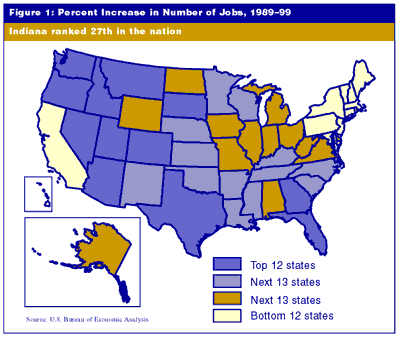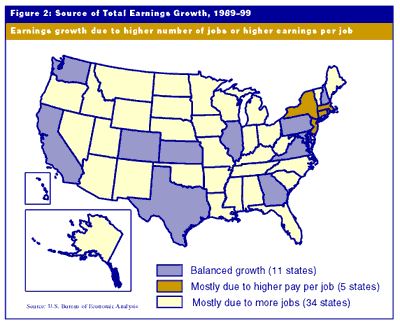Indiana Job Growth Tops U.S. Average
Indiana added jobs at a faster rate than did the nation over the years 1989 to 1999, with a total addition of 615,000 jobs. With that 20.3% gain, Indiana ranked 27th in the nation, ahead of neighboring states Illinois, Michigan and Ohio. For the same period, the nation had a 19.3% increase (see Figure 1).

Job growth is closely related to population growth. Thus Nevada, Utah, Arizona and Idaho led the percentage derby. Only the District of Columbia had fewer jobs in 1999 than 10 years earlier. However, Rhode Island, Connecticut, New York and New Jersey each had job growth rates of 6% or less.
Job growth alone can contribute to growing earnings, the aggregate compensation of workers and to the number of business proprietors. For example, Alaska had an 18% increase in jobs, but only a 6.1% increase in total earnings as average earnings per job fell by 10%. As high-paying energy jobs were eliminated, lower-paying but more numerous service-sector jobs were introduced. Thus whatever growth did occur in total earnings was ultimately the result of increased numbers of jobs.
At the other extreme was the District of Columbia, where 36,400 jobs were lost, a decline of 4.7% over the 10-year period. Average earnings per job rose, though, by 22.7%. (D.C. led the nation in real earnings per job in both 1989 and 1999, with $46,127 and $56,601, respectively.) Under these circumstances, whatever growth occurred in total earnings was ultimately the result of higher-paying jobs.
Nationwide, 58% of the growth in real total earnings between 1989 and 1999 was due to increased numbers of jobs. The balance (42%) of the growth in earnings was the effect of higher pay per job. Indiana had 67% of its increased total earnings arise from job growth-with 33% due to high paying jobs-and was among the majority of the states in that regard (see Figure 2).

There seems to be no statistical relationship between the rate of earnings growth and the share of that growth originating in either job or pay rate increases. Nor is it obvious that job growth or pay increases are universally superior objectives for economic development policy
